Seagate Barracuda 7200.10 750GB: Size Does Matter
by Gary Key on May 18, 2006 9:00 AM EST- Posted in
- Storage
IPEAK File Transfer Tests
Our IPEAK based File Transfer benchmarks indicate how well a drive performs in a strictly read or write operation with a limited number of files (29) but a large amount of data (7.55GB). The test is designed to ensure continual write or read operations across a large section of the drive that requires constant track to track seek requests, actuator movements, and caching large amounts of data.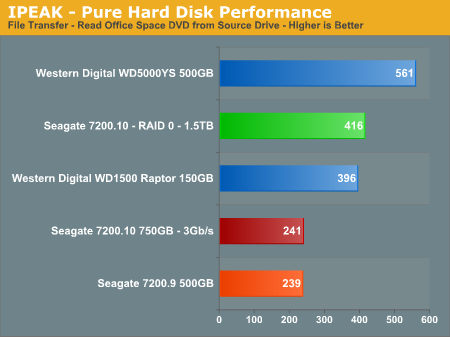
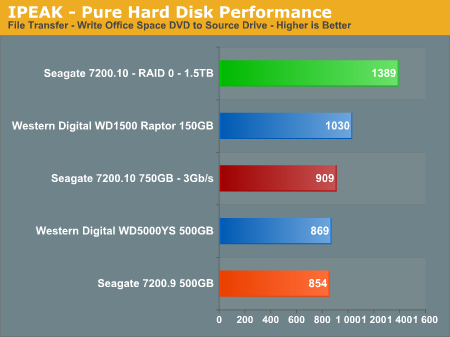
The write performance, and to some degree the read performance, of the 7200.10 RAID 0 combination is impressive in these benchmarks. While we are measuring the actual performance of the hard drive, this is one instance where the RAID 0 setup would show benefits in applications by reducing the time to transfer files.
The Seagate 7200.10 and 7200.9 read performance is dismal compared to the other drives while their write performance is very good. This is very interesting as their read performance in the antivirus test was very good. After further examination of the trace files we noticed the read requests in the antivirus test consisted of mostly small block sizes in irregular patterns compared to very large block sizes in a continual pattern in the file transfer test. It appears in our first couple of benchmarks that the read performance of the 7200.10 drive will be something of interest to look for in the balance of our tests.
Only the RAID 0 result saves the 7200.10 from a very embarrassing performance in this read benchmark and even then it fails to exceed the WD RE2 500GB drive. Speaking of the WD drive, we ran our test repeatedly, created a new trace file, changed drives, and then broke out the stop watch to verify the performance of this drive in our read test. The performance of this drive was fantastic in the read section and quietly fell in behind the Raptor and 7200.10 in the write performance benchmark.
IPEAK Video/Audio Tests
The IPEAK based Video/Audio benchmarks are designed around media encoding and simulating HTPC activities. These are basic benchmarks at this time as this section will be expanded greatly with some new tools that we have developed along with our business partners. Our change to a dual core processor will assist us in maintaining a balance between the CPU and Storage systems during the trace file creation and benchmarking processes. These benchmarks are CPU intensive in nature but also require a balanced storage system with the ability to handle read and write requests simultaneously in a very efficient manner.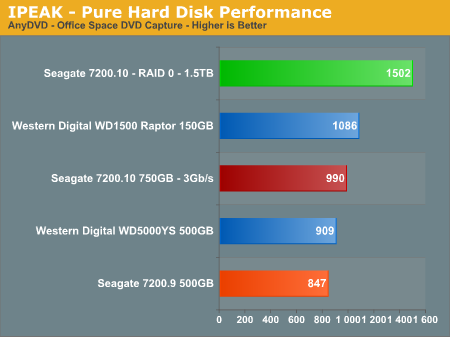
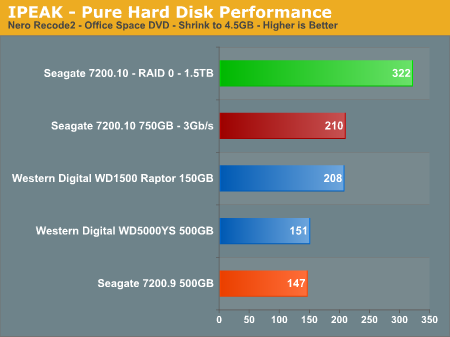
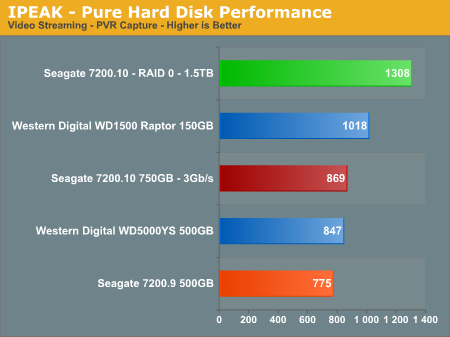
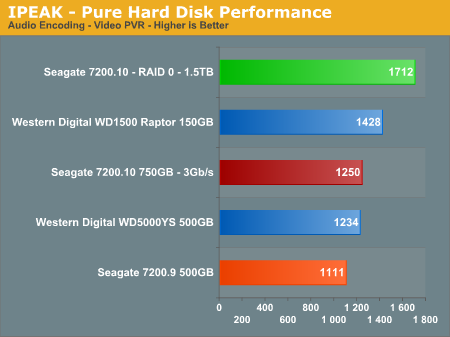
The AnyDVD benchmark is heavily weighted to write requests with the results showing the continued performance advantages of the WD Raptor at the expense of storage capacity, something our Seagate 7200.10 750GB drive has in excess. The performance of the 7200.10 is excellent with a 9% advantage over the WD RE2 and 16% over the 7200.9 drive.
The RAID 0 performance shows the continued strength of this combination in the more intensive I/O benchmarks. Any enthusiasm about the RAID 0 scores should be tempered by the fact that we are measuring hard disk I/O performance and not overall platform performance as several factors within your system can greatly mitigate any advantages we might see in these results. RAID 0 is generally useful in applications where data files are very large and/or data requests are highly sequential in nature, in this case our particular encoding and streaming benchmarks are fit for RAID 0 as it reduces our file transfer times within the actual application.
The NeroRecode 2 benchmark is weighted to streaming read requests but is balanced by continuous write operations. This benchmark is one of the most demanding ones in our test suite with the disk being active the entire trace file with several 100% utilization peaks. The Seagate 7200.10 posts the best scores here with a victory over the Raptor and finishing ahead of the other two 7200 RPM drives by 39%. The inconsistent read results we witnessed earlier were not evident in this benchmark.
Our video and audio encoding benchmarks while streaming a video feed continues to show the strength of the Seagate 7200.10 in the media application benchmarks. While falling behind the Raptor in these two benchmarks, this drive has no trouble finishing ahead of its main competition. The Seagate 7200.10 outperforms the 7200.9 by 12% in both of the media multitasking benchmarks. The drive has very balanced performance and would easily be at home in a HTPC configuration. In fact, this drive should have "PVR Recommended" stamped all over it provided the acoustic levels are acceptable.










44 Comments
View All Comments
Larso - Monday, May 22, 2006 - link
Well, you usually plot dB on a linear axis, taken for granted that the interpreter knows the exponential nature of decibels (+10 dB sounds like doubling the loudness). But since our ears/brain also interpret sound levels in an exponential fashion, its not _that_ misleading...
If you really want to show the soundlevel in a linear fashion, you would have to measure loudness in http://en.wikipedia.org/wiki/Sone">Sone
- Gary: Sorry if I've missed it, when you measured the loudness, was the drive secured to the case with screws, or was it suspended softly? It would be interesting to know how much of the noise was due to vibration, and how much was actual noise emission from the drive.
Perhaps some kind of soft suspension would make the drive noise more bearable, subjectively?
Gary Key - Thursday, May 25, 2006 - link
The drives are suspended via soft rubber bushings in the drive cage in order to equalize the test results between drives (as much as possible). This drive will create an additional low pitch vibration when attached directly but nothing like the sound a Raptor produces when attached directly, subjective opinion of course. :)
TonyB - Thursday, May 18, 2006 - link
how soon till we see 1TB hard drive. 7200.11?Gary Key - Thursday, May 18, 2006 - link
We should see a 960GB drive by Q4. We will see the 1TB+ drives in 2007, maybe earlier depending on how well the new 200GB plus platters test out. Also, if Hitachi or WD press Seagate on the issue in Q4 I am sure it be out early. ;->Zaitsev - Thursday, May 18, 2006 - link
Page 4 reads, "we decided the make the switch at this time as the performance."I enjoyed the article, Gary.
"I would much rather show the benefits of RAID 5, 0+1, 10 in a separate article"
I think that's a great idea, and am looking forward to it.
Gary Key - Thursday, May 18, 2006 - link
The link highlight on the word "applications" right before "we" is hiding the semi-colon somewhat. I will see if we can edit the hyperlink to correct this. :)
Thanks for the comments. We are trying to head in a more technical direction in the storage section. We have some additional audio/video tests coming along with application timer benchmarks that should lighten up the presentation. Also, we did not report WB99, IPEAK Access, Disk Bench, IOMeter, or other benchmarks yet, still gauging what information is valuable, interesting, and required.
JarredWalton - Thursday, May 18, 2006 - link
Actually, he was referring to the word "the" - fixed now, as it should have been "to". :)Zaitsev - Thursday, May 18, 2006 - link
Sorry about that. I will be more clear next time. :)Gary Key - Thursday, May 18, 2006 - link
I will wear my glasses next time.... LOL
peternelson - Thursday, May 18, 2006 - link
Hi,
I can understand why you want to test sound levels as close as 5mm.
However, to someone quickly looking at the results charts without carefully reading the text they might think your db(A)@5mm are comparable with db(A) measurements taken at more conventional distances like 1 metre away.
To avoid such errors being made when comparing BETWEEN reviews, please clearly label the audio charts not just "db" but "db(A)@5mm"